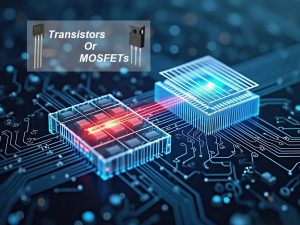
Navigating the world of electronic components can feel complex. When it comes to amplification and switching, transistors and MOSFETs are key. Both are vital in many circuits, but their distinct features are crucial for making the right choice for your project. Let’s explore their core differences.
The Fundamental Difference: Control Mechanism
Both transistors and MOSFETs (Metal-Oxide-Semiconductor Field-Effect Transistors) act as electronic switches or amplifiers. However, how they control this differs greatly. Traditional bipolar junction transistors (BJTs) use both electrons and holes and are current-controlled. A small current to the base controls a larger current between the collector and emitter.
MOSFETs, on the other hand, are voltage-controlled field-effect transistors. Voltage applied to the gate creates an electric field. This field changes the conductivity of a channel between the source and drain. This difference in control is key to their varied performance.
MOSFET Advantages: High Input Impedance and Speed
One major plus for MOSFETs is their high input impedance. The gate is insulated, so almost no current flows into it. This makes MOSFETs great for situations needing minimal impact on the preceding circuit, like high-impedance sensors and voltage amplifiers. BJTs, being current-driven, have lower input impedance, which can sometimes affect the circuit before them.
MOSFETs also generally switch faster than BJTs, especially at higher frequencies. This makes them preferred for power switching in power supplies and motor control, where quick and efficient switching minimizes power loss.
BJT Strengths: Current Gain and Robustness
However, BJTs are still useful in some areas. They often have higher current gain and can handle large currents well. This suits them for high-power amplification and switching where power handling is most important. Also, BJTs can be more cost-effective for simpler, low-frequency uses.
Choosing the Right Component: Key Considerations
So, how do you pick the right component for your project? Think about these points:
- Control Signal: Is your control signal mainly voltage or current? MOSFETs work best with voltage, while BJTs need current.
- Input Impedance: Do you need high input impedance to avoid loading? MOSFETs are the better choice.
- Switching Speed: Does your application need fast switching? MOSFETs usually perform better at higher frequencies.
- Power Requirements: What are the current and voltage needs? BJTs might be better for very high currents, while MOSFETs are efficient for many power levels.
- Cost and Complexity: For simple, low-frequency circuits, BJTs might be cheaper. MOSFET circuits can sometimes be a bit more complex to drive.
Conclusion: Matching the Component to Your Needs
In summary, both transistors and MOSFETs are vital in electronics, each with its own strengths. By carefully looking at your project’s specific needs, you can confidently choose the component that will give the best performance and efficiency. Understanding their core differences in control, impedance, speed, and power handling is key to successful electronic designs.
